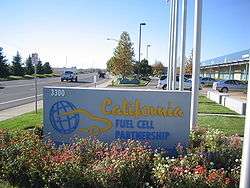California Fuel Cell Partnership
The California Fuel Cell Partnership is a public-private partnership to promote hydrogen vehicles (including cars and buses) in California. It is notable as one of the first initiatives for that purpose undertaken in the United States.

In January 1999, two state government agencies—California Air Resources Board and California Energy Commission joined with six private sector companies—Ballard Power Systems, DaimlerChrysler, Ford Motor Company, BP, Shell Hydrogen and ChevronTexaco—to form the California Fuel Cell Partnership. The goal was to demonstrate and promote the potential for fuel cell vehicles as a clean, safe, and practical alternative to vehicles powered by internal combustion engines. Within a very short time, other government agencies and private businesses became members.
In November 2000, the West Sacramento headquarters opened. The building includes a public gallery, offices, a hydrogen fueling station and indoor service bays for vehicle maintenance. At first, the automakers had just handful of cars all stationed in Sacramento. The goal was to see if these vehicles and fuel could be technically viable. If the answer was no, then CaFCP would close its doors in 2004.
Before the first phase was finished, CaFCP members knew that the technology could succeed. The number of members grew to 33 and set a new set of goals for the next phase of operation, from 2004-2007. During this period, CaFCP members worked on project to prove or disprove the commercially viability—would the vehicles, fuels and public policies meet consumer expectations?
In mid-2006, the members agreed that FCVs could be a commercial success. They agreed to a third phase through the end of 2012 to lay the foundations for a commercial market, which includes developing early retail stations, policies to enable the sale of retail hydrogen and necessary steps to building a supplier base for large-scale production in the future.
CaFCP completed its first phase of operation in December, 2003. The second phase will conclude in December, 2007. In mid-2006, the members agreed to enter a third phase to encourage fuel cell vehicle commercialization that will continue through 2012.
Membership
The California Fuel Cell Partnership is a unique collaborative of auto manufacturers, energy companies, fuel cell technology companies and government agencies. The members collaborate on activities that advance the technology, such as first responder training, community outreach and agreeing on protocols while standards are being developed.
Automotive members provide fuel cell passenger vehicles that are placed in demonstration programs, where they are tested in real-world driving conditions.
Energy members work to build hydrogen stations within an infrastructure that is safe, convenient and fits into the community.
Fuel cell technology members provide fuel cells for passenger vehicles and transit buses.
Government members lay the groundwork for demonstration programs by facilitating steps to creating a hydrogen fueling infrastructure.
Full members
Automobile makers
- Chrysler On occasion, free tours are offered to the public where they take a guided tour of the facility and ride in the hydrogen-powered vehicles
- Daimler
- General Motors
- Honda
- Hyundai
- Nissan
- Toyota
- Volkswagen
Hydrogen Fuel Cells
Energy Companies
Government Agencies
- California Air Resources Board
- California Energy Commission
- United States Department of Energy
- United States Department of Transportation
- United States Environmental Protection Agency
- South Coast Air Quality Management District
Associate Members
Associate members assist the full members meet the partnership's objectives by helping in specific areas of expertise.
Transit Agencies
- Alameda-Contra Costa Transit District
- SunLine Transit
- Santa Clara Valley Transportation Authority (Santa Clara VTA).
Fueling Providers
- Air Products
- Powertech Labs, Inc.
- Praxair
- Proton Energy Systems, Inc.,
Others
- California Department of Food and Agriculture
- Institute of Transportation Studies, UC Davis
- National Fuel Cell Research Center, UC Irvine